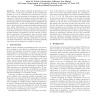Free Online Productivity Tools
i2Speak
i2Symbol
i2OCR
iTex2Img
iWeb2Print
iWeb2Shot
i2Type
iPdf2Split
iPdf2Merge
i2Bopomofo
i2Arabic
i2Style
i2Image
i2PDF
iLatex2Rtf
Sci2ools
ECAI
2004
Springer
2004
Springer
Symmetry Breaking as a Prelude to Implied Constraints: A Constraint Modelling Pattern
Finite-domain constraint programming can be used to solve a wide range of problems by first modelling the problem as a set of constraints that characterise the problem’s solutions, then searching for solutions that satisfy the constraints. Experts often augment models with implied constraints and constraints that break symmetries in the model. An emerging pattern in the modelling process, highlighted and demonstrated here, is that some powerful implied constraints can be derived only after symmetry-breaking constraints have been added. Furthermore, the choice between alternative symmetry-breaking constraints is commonly made by considering either the amount of symmetry broken or the strength of pruning obtained in comparison with the overhead of enforcing the constraints. We demonstrate that the choice should also consider the strength of the implied constraints derivable from the symmetry breaking constraints. We also discuss future automation of the selection of symmetry-breaking ...
Artificial Intelligence | ECAI 2004 | Implied Constraints | Powerful Implied Constraints | Symmetry-breaking Constraints |
| Added | 01 Jul 2010 |
| Updated | 01 Jul 2010 |
| Type | Conference |
| Year | 2004 |
| Where | ECAI |
| Authors | Alan M. Frisch, Christopher Jefferson, Ian Miguel |
Comments (0)

